Global Human Resource Management: Talent and Resourcing Report
VerifiedAdded on 2022/08/12
|18
|5203
|12
Report
AI Summary
This report delves into the multifaceted realm of global human resource management, examining crucial aspects such as employee resourcing, talent management strategies, and the dynamics of the evolving employment market. The introduction establishes the significance of these functions in achieving organizational goals, emphasizing the need for effective strategies in attracting and retaining top talent. The report then explores the changing employment market, highlighting the impact of demographic shifts, technological advancements, and evolving employee preferences. It analyzes contemporary approaches to employee resources and talent management, including job descriptions, development opportunities, performance assessments, and compensation strategies. Furthermore, the report outlines the essential functions of HR professionals, including recruitment, training, performance appraisal, and employee relations. The report concludes by summarizing the key findings and implications for organizations operating in the global landscape, offering insights into how to navigate the challenges and leverage opportunities in talent acquisition and management.
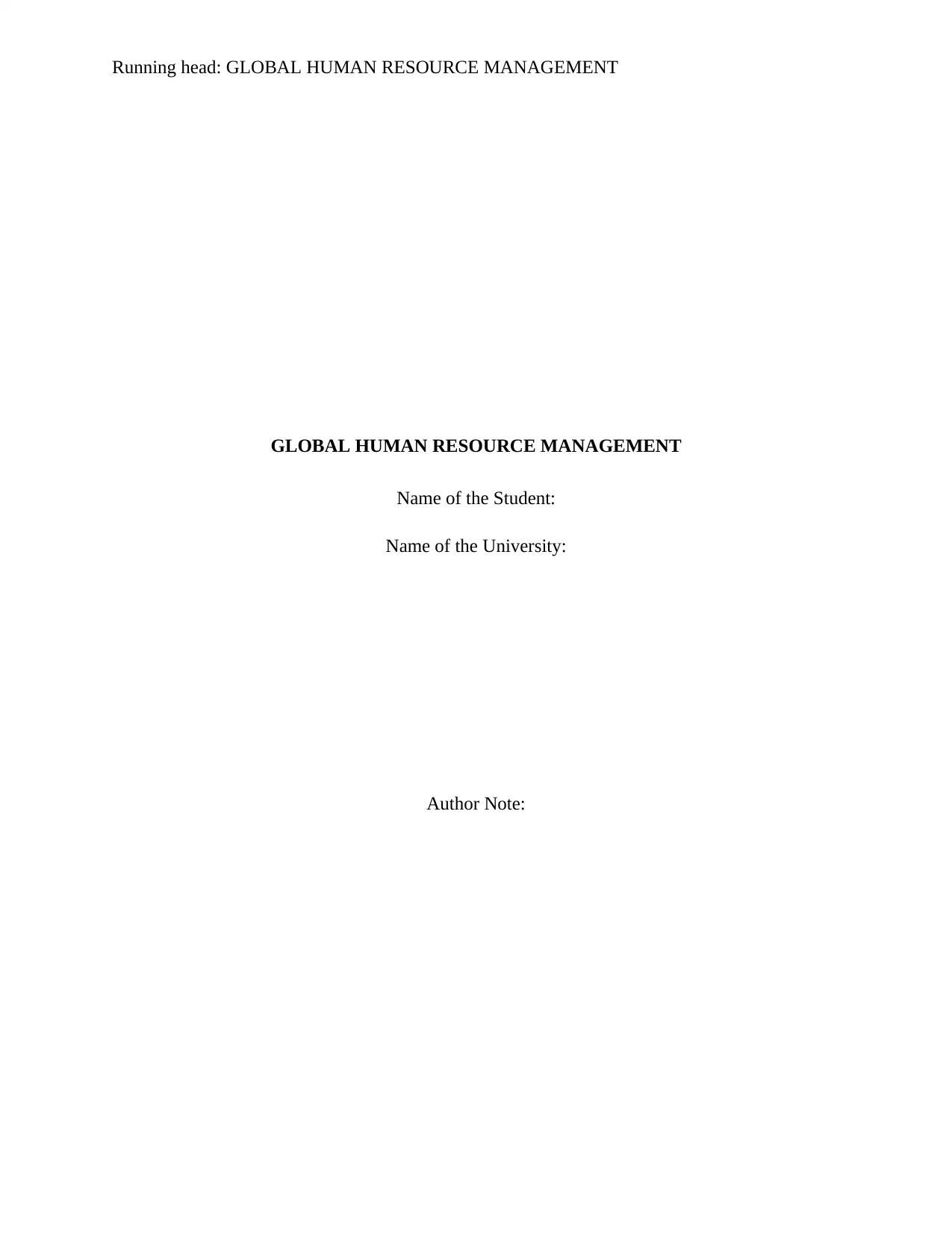
Running head: GLOBAL HUMAN RESOURCE MANAGEMENT
GLOBAL HUMAN RESOURCE MANAGEMENT
Name of the Student:
Name of the University:
Author Note:
GLOBAL HUMAN RESOURCE MANAGEMENT
Name of the Student:
Name of the University:
Author Note:
Paraphrase This Document
Need a fresh take? Get an instant paraphrase of this document with our AI Paraphraser
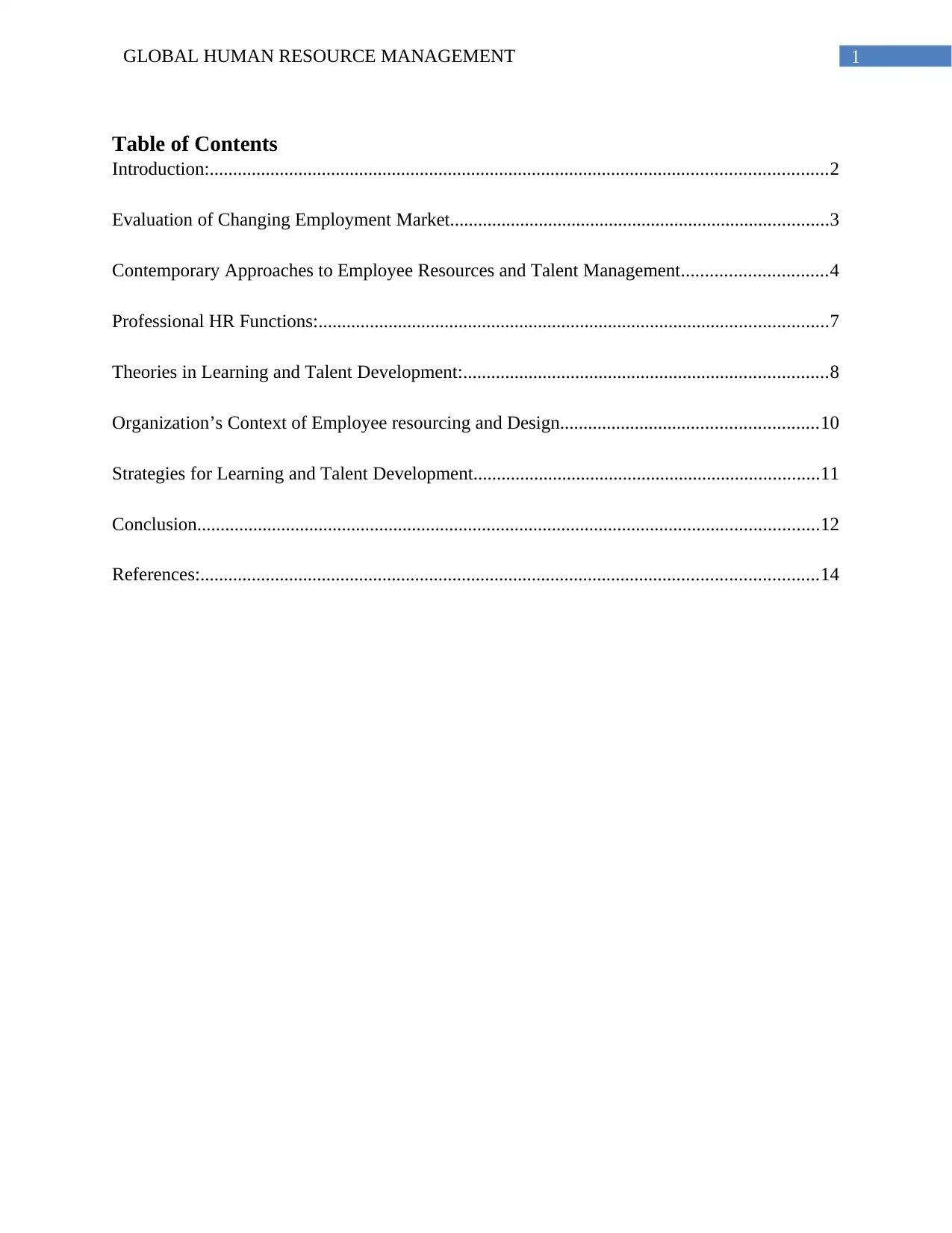
1GLOBAL HUMAN RESOURCE MANAGEMENT
Table of Contents
Introduction:....................................................................................................................................2
Evaluation of Changing Employment Market.................................................................................3
Contemporary Approaches to Employee Resources and Talent Management...............................4
Professional HR Functions:.............................................................................................................7
Theories in Learning and Talent Development:..............................................................................8
Organization’s Context of Employee resourcing and Design.......................................................10
Strategies for Learning and Talent Development..........................................................................11
Conclusion.....................................................................................................................................12
References:....................................................................................................................................14
Table of Contents
Introduction:....................................................................................................................................2
Evaluation of Changing Employment Market.................................................................................3
Contemporary Approaches to Employee Resources and Talent Management...............................4
Professional HR Functions:.............................................................................................................7
Theories in Learning and Talent Development:..............................................................................8
Organization’s Context of Employee resourcing and Design.......................................................10
Strategies for Learning and Talent Development..........................................................................11
Conclusion.....................................................................................................................................12
References:....................................................................................................................................14
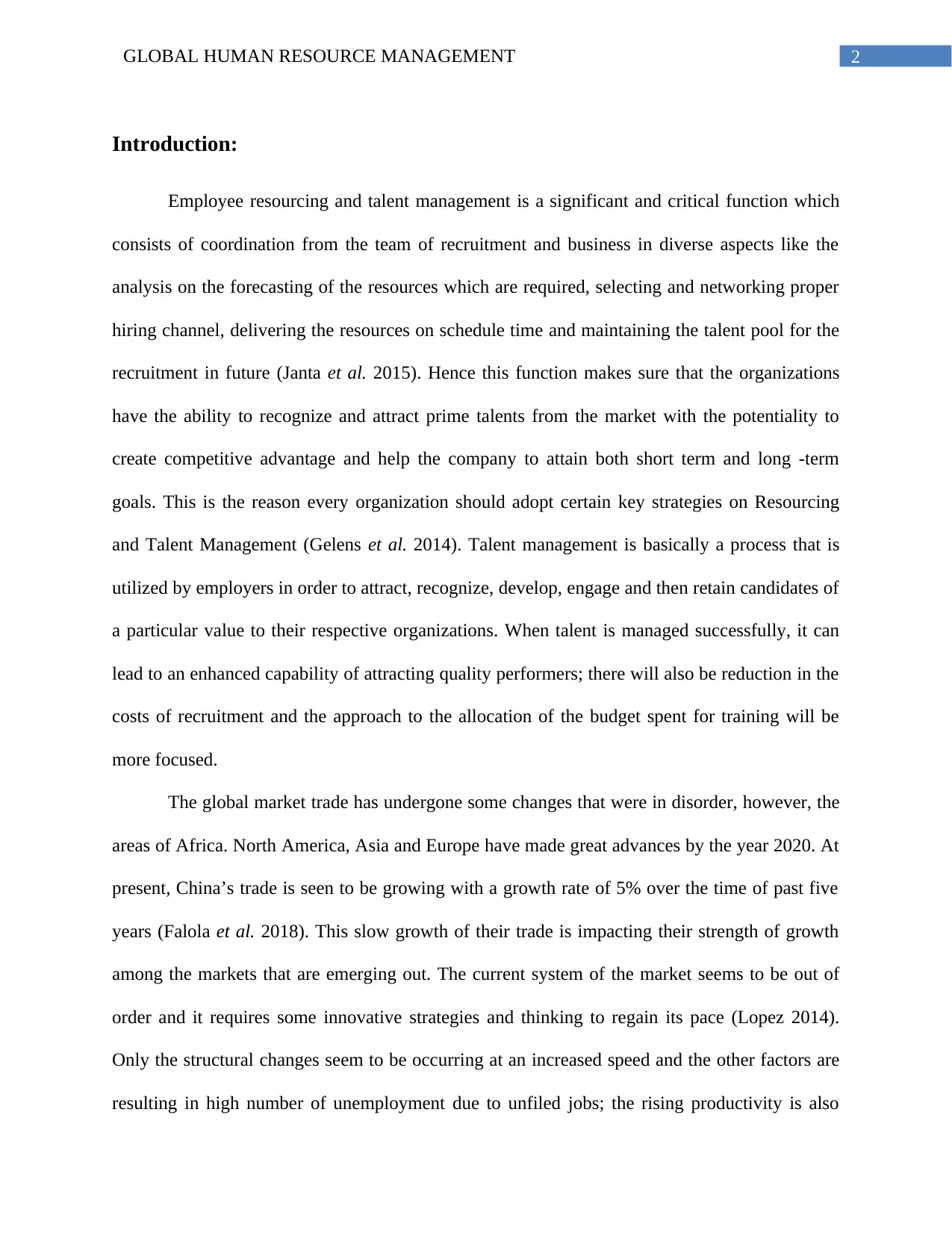
2GLOBAL HUMAN RESOURCE MANAGEMENT
Introduction:
Employee resourcing and talent management is a significant and critical function which
consists of coordination from the team of recruitment and business in diverse aspects like the
analysis on the forecasting of the resources which are required, selecting and networking proper
hiring channel, delivering the resources on schedule time and maintaining the talent pool for the
recruitment in future (Janta et al. 2015). Hence this function makes sure that the organizations
have the ability to recognize and attract prime talents from the market with the potentiality to
create competitive advantage and help the company to attain both short term and long -term
goals. This is the reason every organization should adopt certain key strategies on Resourcing
and Talent Management (Gelens et al. 2014). Talent management is basically a process that is
utilized by employers in order to attract, recognize, develop, engage and then retain candidates of
a particular value to their respective organizations. When talent is managed successfully, it can
lead to an enhanced capability of attracting quality performers; there will also be reduction in the
costs of recruitment and the approach to the allocation of the budget spent for training will be
more focused.
The global market trade has undergone some changes that were in disorder, however, the
areas of Africa. North America, Asia and Europe have made great advances by the year 2020. At
present, China’s trade is seen to be growing with a growth rate of 5% over the time of past five
years (Falola et al. 2018). This slow growth of their trade is impacting their strength of growth
among the markets that are emerging out. The current system of the market seems to be out of
order and it requires some innovative strategies and thinking to regain its pace (Lopez 2014).
Only the structural changes seem to be occurring at an increased speed and the other factors are
resulting in high number of unemployment due to unfiled jobs; the rising productivity is also
Introduction:
Employee resourcing and talent management is a significant and critical function which
consists of coordination from the team of recruitment and business in diverse aspects like the
analysis on the forecasting of the resources which are required, selecting and networking proper
hiring channel, delivering the resources on schedule time and maintaining the talent pool for the
recruitment in future (Janta et al. 2015). Hence this function makes sure that the organizations
have the ability to recognize and attract prime talents from the market with the potentiality to
create competitive advantage and help the company to attain both short term and long -term
goals. This is the reason every organization should adopt certain key strategies on Resourcing
and Talent Management (Gelens et al. 2014). Talent management is basically a process that is
utilized by employers in order to attract, recognize, develop, engage and then retain candidates of
a particular value to their respective organizations. When talent is managed successfully, it can
lead to an enhanced capability of attracting quality performers; there will also be reduction in the
costs of recruitment and the approach to the allocation of the budget spent for training will be
more focused.
The global market trade has undergone some changes that were in disorder, however, the
areas of Africa. North America, Asia and Europe have made great advances by the year 2020. At
present, China’s trade is seen to be growing with a growth rate of 5% over the time of past five
years (Falola et al. 2018). This slow growth of their trade is impacting their strength of growth
among the markets that are emerging out. The current system of the market seems to be out of
order and it requires some innovative strategies and thinking to regain its pace (Lopez 2014).
Only the structural changes seem to be occurring at an increased speed and the other factors are
resulting in high number of unemployment due to unfiled jobs; the rising productivity is also
⊘ This is a preview!⊘
Do you want full access?
Subscribe today to unlock all pages.

Trusted by 1+ million students worldwide
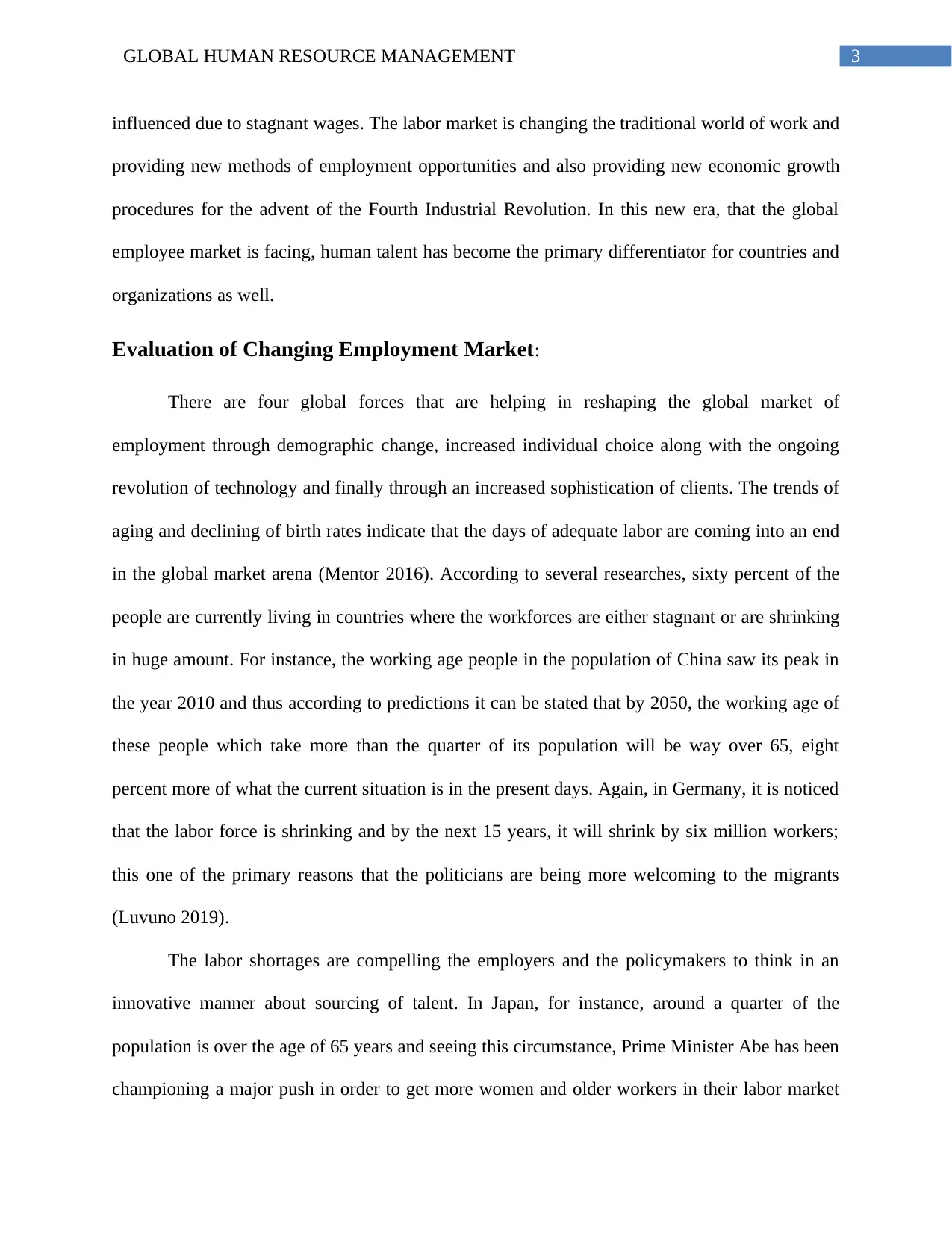
3GLOBAL HUMAN RESOURCE MANAGEMENT
influenced due to stagnant wages. The labor market is changing the traditional world of work and
providing new methods of employment opportunities and also providing new economic growth
procedures for the advent of the Fourth Industrial Revolution. In this new era, that the global
employee market is facing, human talent has become the primary differentiator for countries and
organizations as well.
Evaluation of Changing Employment Market:
There are four global forces that are helping in reshaping the global market of
employment through demographic change, increased individual choice along with the ongoing
revolution of technology and finally through an increased sophistication of clients. The trends of
aging and declining of birth rates indicate that the days of adequate labor are coming into an end
in the global market arena (Mentor 2016). According to several researches, sixty percent of the
people are currently living in countries where the workforces are either stagnant or are shrinking
in huge amount. For instance, the working age people in the population of China saw its peak in
the year 2010 and thus according to predictions it can be stated that by 2050, the working age of
these people which take more than the quarter of its population will be way over 65, eight
percent more of what the current situation is in the present days. Again, in Germany, it is noticed
that the labor force is shrinking and by the next 15 years, it will shrink by six million workers;
this one of the primary reasons that the politicians are being more welcoming to the migrants
(Luvuno 2019).
The labor shortages are compelling the employers and the policymakers to think in an
innovative manner about sourcing of talent. In Japan, for instance, around a quarter of the
population is over the age of 65 years and seeing this circumstance, Prime Minister Abe has been
championing a major push in order to get more women and older workers in their labor market
influenced due to stagnant wages. The labor market is changing the traditional world of work and
providing new methods of employment opportunities and also providing new economic growth
procedures for the advent of the Fourth Industrial Revolution. In this new era, that the global
employee market is facing, human talent has become the primary differentiator for countries and
organizations as well.
Evaluation of Changing Employment Market:
There are four global forces that are helping in reshaping the global market of
employment through demographic change, increased individual choice along with the ongoing
revolution of technology and finally through an increased sophistication of clients. The trends of
aging and declining of birth rates indicate that the days of adequate labor are coming into an end
in the global market arena (Mentor 2016). According to several researches, sixty percent of the
people are currently living in countries where the workforces are either stagnant or are shrinking
in huge amount. For instance, the working age people in the population of China saw its peak in
the year 2010 and thus according to predictions it can be stated that by 2050, the working age of
these people which take more than the quarter of its population will be way over 65, eight
percent more of what the current situation is in the present days. Again, in Germany, it is noticed
that the labor force is shrinking and by the next 15 years, it will shrink by six million workers;
this one of the primary reasons that the politicians are being more welcoming to the migrants
(Luvuno 2019).
The labor shortages are compelling the employers and the policymakers to think in an
innovative manner about sourcing of talent. In Japan, for instance, around a quarter of the
population is over the age of 65 years and seeing this circumstance, Prime Minister Abe has been
championing a major push in order to get more women and older workers in their labor market
Paraphrase This Document
Need a fresh take? Get an instant paraphrase of this document with our AI Paraphraser
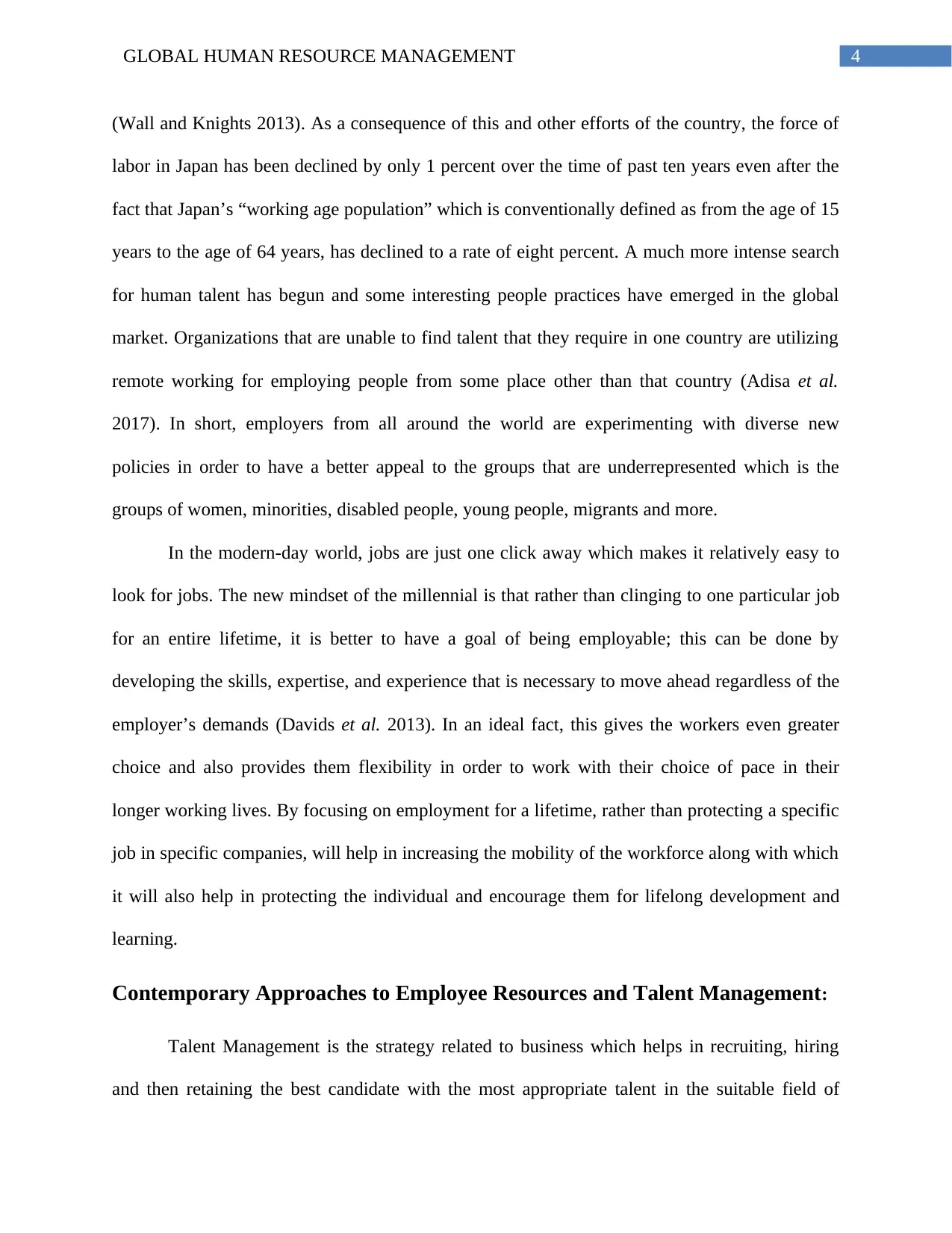
4GLOBAL HUMAN RESOURCE MANAGEMENT
(Wall and Knights 2013). As a consequence of this and other efforts of the country, the force of
labor in Japan has been declined by only 1 percent over the time of past ten years even after the
fact that Japan’s “working age population” which is conventionally defined as from the age of 15
years to the age of 64 years, has declined to a rate of eight percent. A much more intense search
for human talent has begun and some interesting people practices have emerged in the global
market. Organizations that are unable to find talent that they require in one country are utilizing
remote working for employing people from some place other than that country (Adisa et al.
2017). In short, employers from all around the world are experimenting with diverse new
policies in order to have a better appeal to the groups that are underrepresented which is the
groups of women, minorities, disabled people, young people, migrants and more.
In the modern-day world, jobs are just one click away which makes it relatively easy to
look for jobs. The new mindset of the millennial is that rather than clinging to one particular job
for an entire lifetime, it is better to have a goal of being employable; this can be done by
developing the skills, expertise, and experience that is necessary to move ahead regardless of the
employer’s demands (Davids et al. 2013). In an ideal fact, this gives the workers even greater
choice and also provides them flexibility in order to work with their choice of pace in their
longer working lives. By focusing on employment for a lifetime, rather than protecting a specific
job in specific companies, will help in increasing the mobility of the workforce along with which
it will also help in protecting the individual and encourage them for lifelong development and
learning.
Contemporary Approaches to Employee Resources and Talent Management:
Talent Management is the strategy related to business which helps in recruiting, hiring
and then retaining the best candidate with the most appropriate talent in the suitable field of
(Wall and Knights 2013). As a consequence of this and other efforts of the country, the force of
labor in Japan has been declined by only 1 percent over the time of past ten years even after the
fact that Japan’s “working age population” which is conventionally defined as from the age of 15
years to the age of 64 years, has declined to a rate of eight percent. A much more intense search
for human talent has begun and some interesting people practices have emerged in the global
market. Organizations that are unable to find talent that they require in one country are utilizing
remote working for employing people from some place other than that country (Adisa et al.
2017). In short, employers from all around the world are experimenting with diverse new
policies in order to have a better appeal to the groups that are underrepresented which is the
groups of women, minorities, disabled people, young people, migrants and more.
In the modern-day world, jobs are just one click away which makes it relatively easy to
look for jobs. The new mindset of the millennial is that rather than clinging to one particular job
for an entire lifetime, it is better to have a goal of being employable; this can be done by
developing the skills, expertise, and experience that is necessary to move ahead regardless of the
employer’s demands (Davids et al. 2013). In an ideal fact, this gives the workers even greater
choice and also provides them flexibility in order to work with their choice of pace in their
longer working lives. By focusing on employment for a lifetime, rather than protecting a specific
job in specific companies, will help in increasing the mobility of the workforce along with which
it will also help in protecting the individual and encourage them for lifelong development and
learning.
Contemporary Approaches to Employee Resources and Talent Management:
Talent Management is the strategy related to business which helps in recruiting, hiring
and then retaining the best candidate with the most appropriate talent in the suitable field of
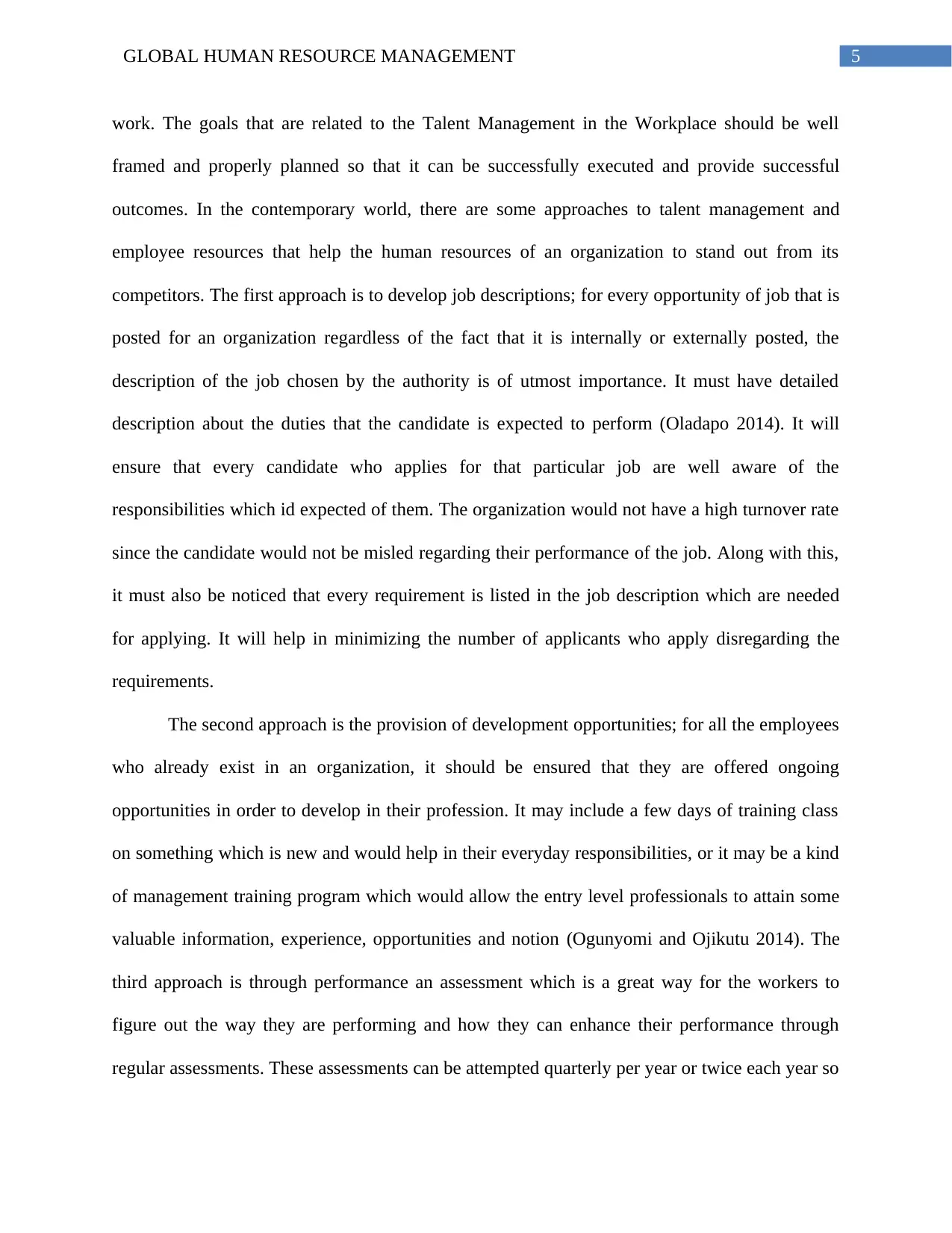
5GLOBAL HUMAN RESOURCE MANAGEMENT
work. The goals that are related to the Talent Management in the Workplace should be well
framed and properly planned so that it can be successfully executed and provide successful
outcomes. In the contemporary world, there are some approaches to talent management and
employee resources that help the human resources of an organization to stand out from its
competitors. The first approach is to develop job descriptions; for every opportunity of job that is
posted for an organization regardless of the fact that it is internally or externally posted, the
description of the job chosen by the authority is of utmost importance. It must have detailed
description about the duties that the candidate is expected to perform (Oladapo 2014). It will
ensure that every candidate who applies for that particular job are well aware of the
responsibilities which id expected of them. The organization would not have a high turnover rate
since the candidate would not be misled regarding their performance of the job. Along with this,
it must also be noticed that every requirement is listed in the job description which are needed
for applying. It will help in minimizing the number of applicants who apply disregarding the
requirements.
The second approach is the provision of development opportunities; for all the employees
who already exist in an organization, it should be ensured that they are offered ongoing
opportunities in order to develop in their profession. It may include a few days of training class
on something which is new and would help in their everyday responsibilities, or it may be a kind
of management training program which would allow the entry level professionals to attain some
valuable information, experience, opportunities and notion (Ogunyomi and Ojikutu 2014). The
third approach is through performance an assessment which is a great way for the workers to
figure out the way they are performing and how they can enhance their performance through
regular assessments. These assessments can be attempted quarterly per year or twice each year so
work. The goals that are related to the Talent Management in the Workplace should be well
framed and properly planned so that it can be successfully executed and provide successful
outcomes. In the contemporary world, there are some approaches to talent management and
employee resources that help the human resources of an organization to stand out from its
competitors. The first approach is to develop job descriptions; for every opportunity of job that is
posted for an organization regardless of the fact that it is internally or externally posted, the
description of the job chosen by the authority is of utmost importance. It must have detailed
description about the duties that the candidate is expected to perform (Oladapo 2014). It will
ensure that every candidate who applies for that particular job are well aware of the
responsibilities which id expected of them. The organization would not have a high turnover rate
since the candidate would not be misled regarding their performance of the job. Along with this,
it must also be noticed that every requirement is listed in the job description which are needed
for applying. It will help in minimizing the number of applicants who apply disregarding the
requirements.
The second approach is the provision of development opportunities; for all the employees
who already exist in an organization, it should be ensured that they are offered ongoing
opportunities in order to develop in their profession. It may include a few days of training class
on something which is new and would help in their everyday responsibilities, or it may be a kind
of management training program which would allow the entry level professionals to attain some
valuable information, experience, opportunities and notion (Ogunyomi and Ojikutu 2014). The
third approach is through performance an assessment which is a great way for the workers to
figure out the way they are performing and how they can enhance their performance through
regular assessments. These assessments can be attempted quarterly per year or twice each year so
⊘ This is a preview!⊘
Do you want full access?
Subscribe today to unlock all pages.

Trusted by 1+ million students worldwide
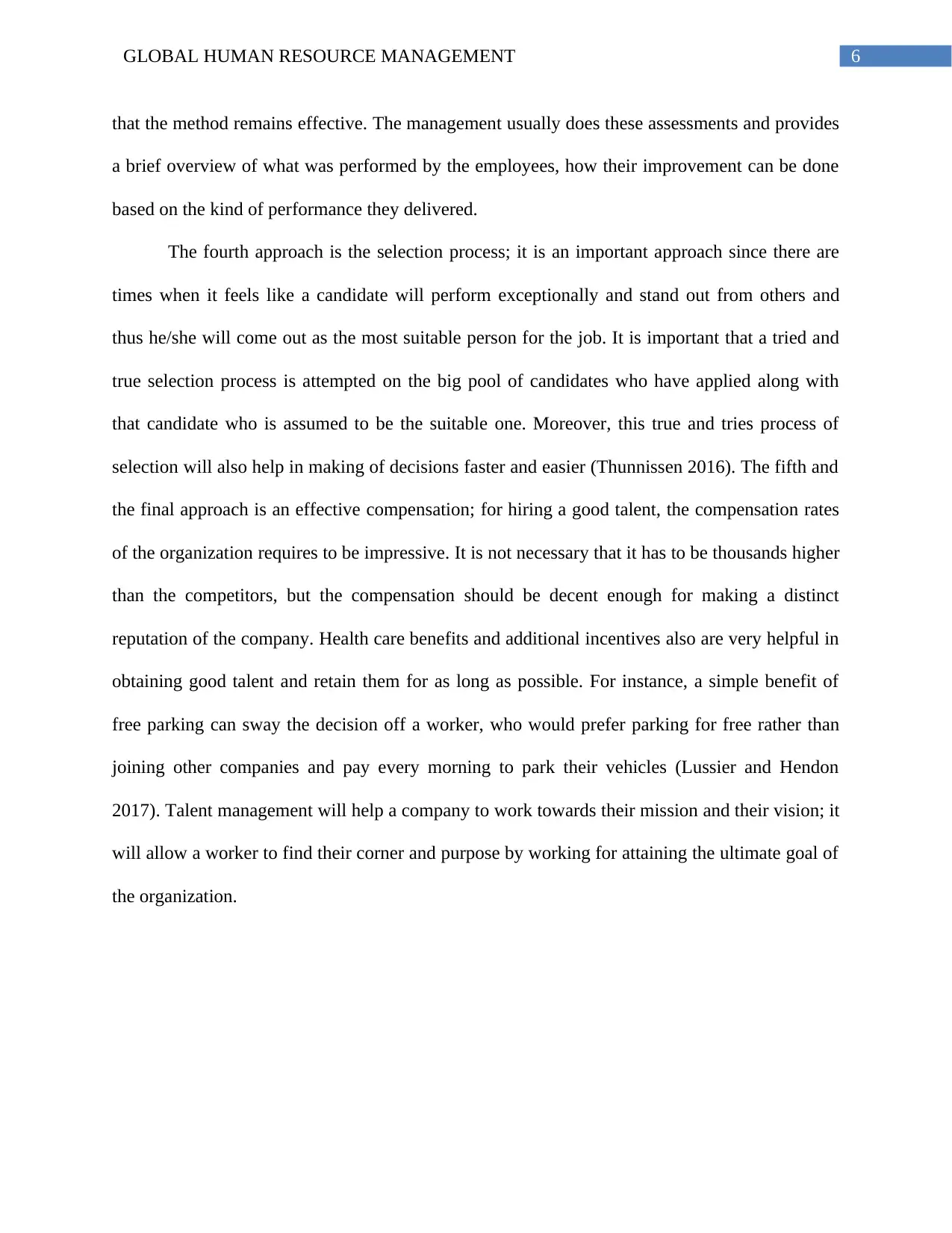
6GLOBAL HUMAN RESOURCE MANAGEMENT
that the method remains effective. The management usually does these assessments and provides
a brief overview of what was performed by the employees, how their improvement can be done
based on the kind of performance they delivered.
The fourth approach is the selection process; it is an important approach since there are
times when it feels like a candidate will perform exceptionally and stand out from others and
thus he/she will come out as the most suitable person for the job. It is important that a tried and
true selection process is attempted on the big pool of candidates who have applied along with
that candidate who is assumed to be the suitable one. Moreover, this true and tries process of
selection will also help in making of decisions faster and easier (Thunnissen 2016). The fifth and
the final approach is an effective compensation; for hiring a good talent, the compensation rates
of the organization requires to be impressive. It is not necessary that it has to be thousands higher
than the competitors, but the compensation should be decent enough for making a distinct
reputation of the company. Health care benefits and additional incentives also are very helpful in
obtaining good talent and retain them for as long as possible. For instance, a simple benefit of
free parking can sway the decision off a worker, who would prefer parking for free rather than
joining other companies and pay every morning to park their vehicles (Lussier and Hendon
2017). Talent management will help a company to work towards their mission and their vision; it
will allow a worker to find their corner and purpose by working for attaining the ultimate goal of
the organization.
that the method remains effective. The management usually does these assessments and provides
a brief overview of what was performed by the employees, how their improvement can be done
based on the kind of performance they delivered.
The fourth approach is the selection process; it is an important approach since there are
times when it feels like a candidate will perform exceptionally and stand out from others and
thus he/she will come out as the most suitable person for the job. It is important that a tried and
true selection process is attempted on the big pool of candidates who have applied along with
that candidate who is assumed to be the suitable one. Moreover, this true and tries process of
selection will also help in making of decisions faster and easier (Thunnissen 2016). The fifth and
the final approach is an effective compensation; for hiring a good talent, the compensation rates
of the organization requires to be impressive. It is not necessary that it has to be thousands higher
than the competitors, but the compensation should be decent enough for making a distinct
reputation of the company. Health care benefits and additional incentives also are very helpful in
obtaining good talent and retain them for as long as possible. For instance, a simple benefit of
free parking can sway the decision off a worker, who would prefer parking for free rather than
joining other companies and pay every morning to park their vehicles (Lussier and Hendon
2017). Talent management will help a company to work towards their mission and their vision; it
will allow a worker to find their corner and purpose by working for attaining the ultimate goal of
the organization.
Paraphrase This Document
Need a fresh take? Get an instant paraphrase of this document with our AI Paraphraser
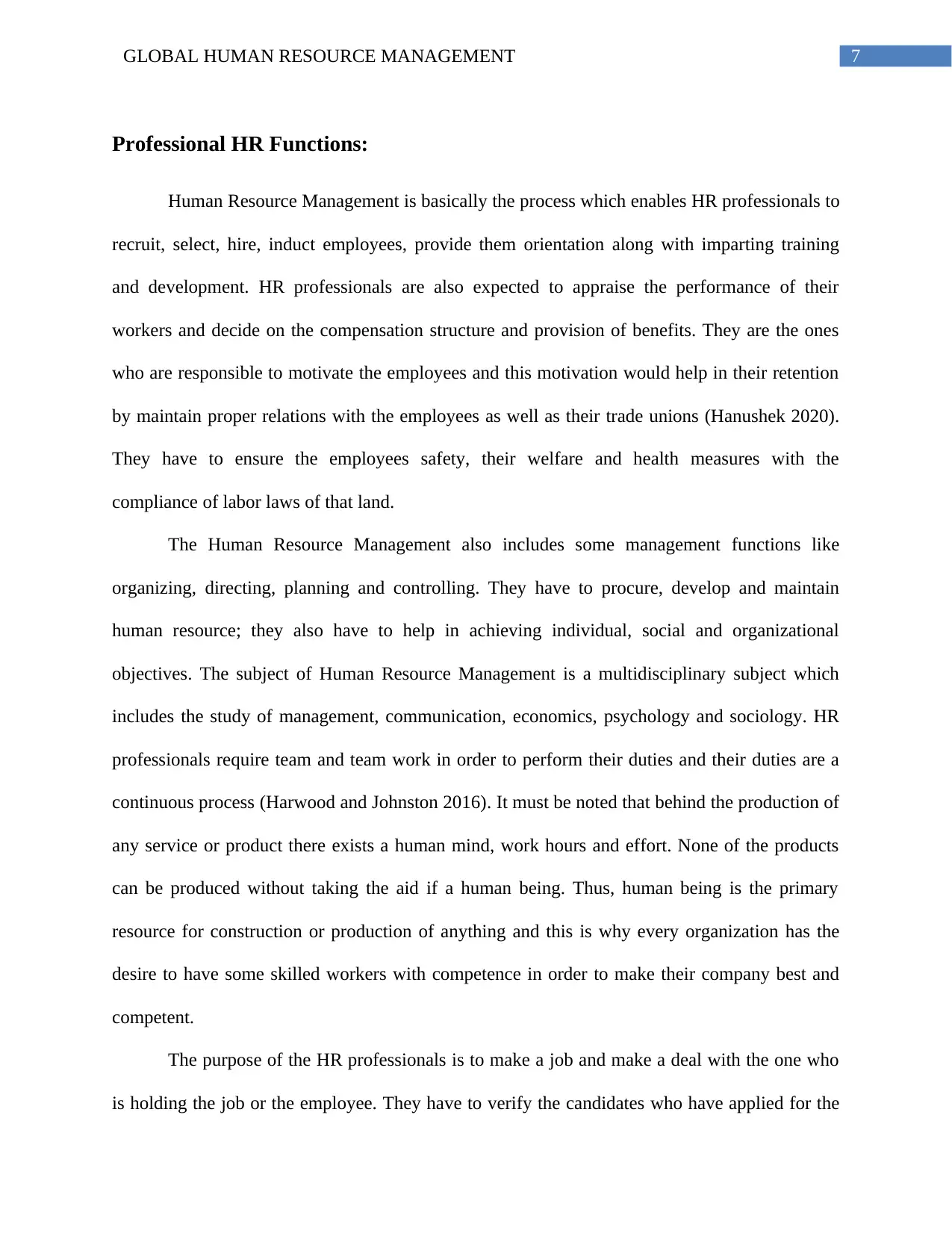
7GLOBAL HUMAN RESOURCE MANAGEMENT
Professional HR Functions:
Human Resource Management is basically the process which enables HR professionals to
recruit, select, hire, induct employees, provide them orientation along with imparting training
and development. HR professionals are also expected to appraise the performance of their
workers and decide on the compensation structure and provision of benefits. They are the ones
who are responsible to motivate the employees and this motivation would help in their retention
by maintain proper relations with the employees as well as their trade unions (Hanushek 2020).
They have to ensure the employees safety, their welfare and health measures with the
compliance of labor laws of that land.
The Human Resource Management also includes some management functions like
organizing, directing, planning and controlling. They have to procure, develop and maintain
human resource; they also have to help in achieving individual, social and organizational
objectives. The subject of Human Resource Management is a multidisciplinary subject which
includes the study of management, communication, economics, psychology and sociology. HR
professionals require team and team work in order to perform their duties and their duties are a
continuous process (Harwood and Johnston 2016). It must be noted that behind the production of
any service or product there exists a human mind, work hours and effort. None of the products
can be produced without taking the aid if a human being. Thus, human being is the primary
resource for construction or production of anything and this is why every organization has the
desire to have some skilled workers with competence in order to make their company best and
competent.
The purpose of the HR professionals is to make a job and make a deal with the one who
is holding the job or the employee. They have to verify the candidates who have applied for the
Professional HR Functions:
Human Resource Management is basically the process which enables HR professionals to
recruit, select, hire, induct employees, provide them orientation along with imparting training
and development. HR professionals are also expected to appraise the performance of their
workers and decide on the compensation structure and provision of benefits. They are the ones
who are responsible to motivate the employees and this motivation would help in their retention
by maintain proper relations with the employees as well as their trade unions (Hanushek 2020).
They have to ensure the employees safety, their welfare and health measures with the
compliance of labor laws of that land.
The Human Resource Management also includes some management functions like
organizing, directing, planning and controlling. They have to procure, develop and maintain
human resource; they also have to help in achieving individual, social and organizational
objectives. The subject of Human Resource Management is a multidisciplinary subject which
includes the study of management, communication, economics, psychology and sociology. HR
professionals require team and team work in order to perform their duties and their duties are a
continuous process (Harwood and Johnston 2016). It must be noted that behind the production of
any service or product there exists a human mind, work hours and effort. None of the products
can be produced without taking the aid if a human being. Thus, human being is the primary
resource for construction or production of anything and this is why every organization has the
desire to have some skilled workers with competence in order to make their company best and
competent.
The purpose of the HR professionals is to make a job and make a deal with the one who
is holding the job or the employee. They have to verify the candidates who have applied for the
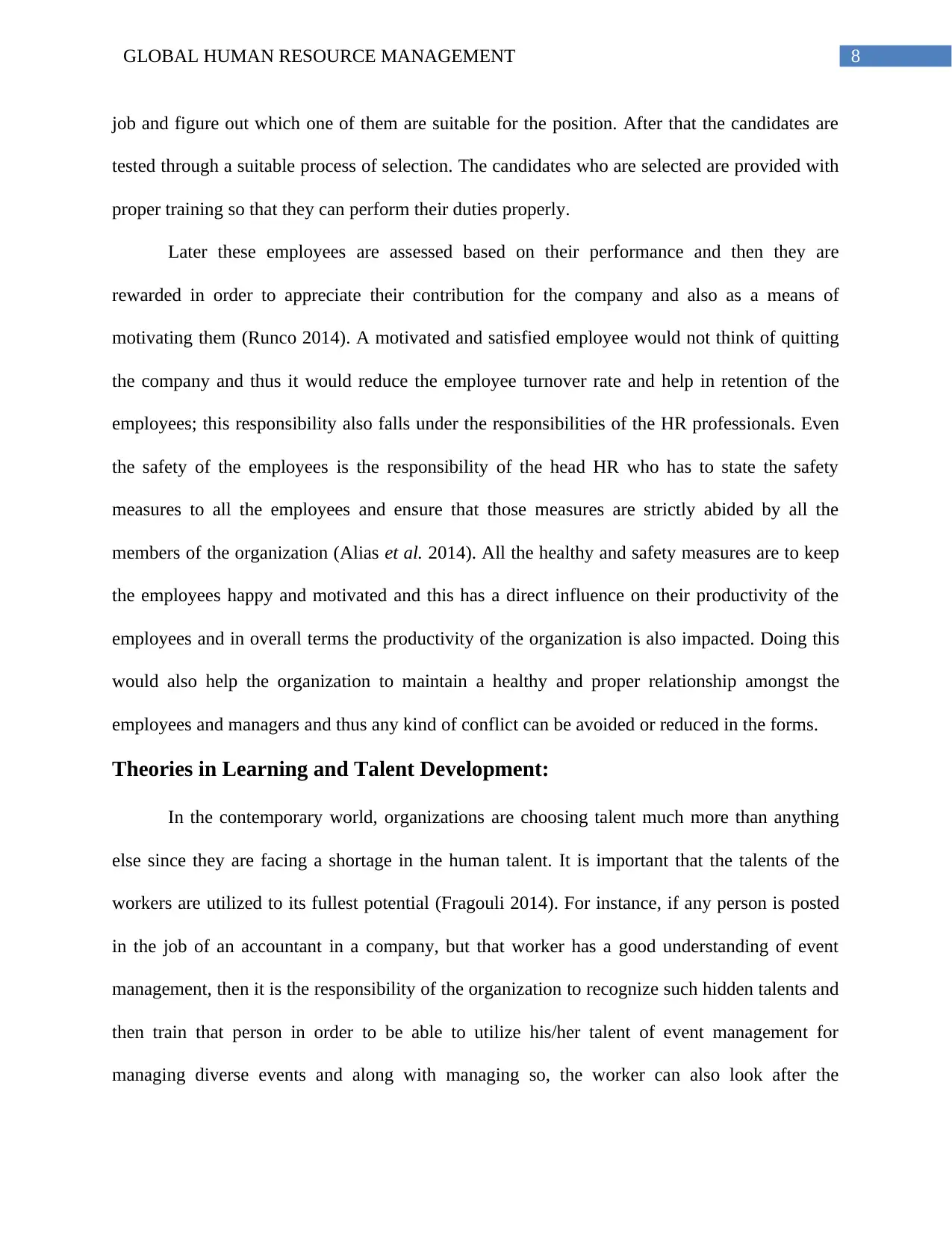
8GLOBAL HUMAN RESOURCE MANAGEMENT
job and figure out which one of them are suitable for the position. After that the candidates are
tested through a suitable process of selection. The candidates who are selected are provided with
proper training so that they can perform their duties properly.
Later these employees are assessed based on their performance and then they are
rewarded in order to appreciate their contribution for the company and also as a means of
motivating them (Runco 2014). A motivated and satisfied employee would not think of quitting
the company and thus it would reduce the employee turnover rate and help in retention of the
employees; this responsibility also falls under the responsibilities of the HR professionals. Even
the safety of the employees is the responsibility of the head HR who has to state the safety
measures to all the employees and ensure that those measures are strictly abided by all the
members of the organization (Alias et al. 2014). All the healthy and safety measures are to keep
the employees happy and motivated and this has a direct influence on their productivity of the
employees and in overall terms the productivity of the organization is also impacted. Doing this
would also help the organization to maintain a healthy and proper relationship amongst the
employees and managers and thus any kind of conflict can be avoided or reduced in the forms.
Theories in Learning and Talent Development:
In the contemporary world, organizations are choosing talent much more than anything
else since they are facing a shortage in the human talent. It is important that the talents of the
workers are utilized to its fullest potential (Fragouli 2014). For instance, if any person is posted
in the job of an accountant in a company, but that worker has a good understanding of event
management, then it is the responsibility of the organization to recognize such hidden talents and
then train that person in order to be able to utilize his/her talent of event management for
managing diverse events and along with managing so, the worker can also look after the
job and figure out which one of them are suitable for the position. After that the candidates are
tested through a suitable process of selection. The candidates who are selected are provided with
proper training so that they can perform their duties properly.
Later these employees are assessed based on their performance and then they are
rewarded in order to appreciate their contribution for the company and also as a means of
motivating them (Runco 2014). A motivated and satisfied employee would not think of quitting
the company and thus it would reduce the employee turnover rate and help in retention of the
employees; this responsibility also falls under the responsibilities of the HR professionals. Even
the safety of the employees is the responsibility of the head HR who has to state the safety
measures to all the employees and ensure that those measures are strictly abided by all the
members of the organization (Alias et al. 2014). All the healthy and safety measures are to keep
the employees happy and motivated and this has a direct influence on their productivity of the
employees and in overall terms the productivity of the organization is also impacted. Doing this
would also help the organization to maintain a healthy and proper relationship amongst the
employees and managers and thus any kind of conflict can be avoided or reduced in the forms.
Theories in Learning and Talent Development:
In the contemporary world, organizations are choosing talent much more than anything
else since they are facing a shortage in the human talent. It is important that the talents of the
workers are utilized to its fullest potential (Fragouli 2014). For instance, if any person is posted
in the job of an accountant in a company, but that worker has a good understanding of event
management, then it is the responsibility of the organization to recognize such hidden talents and
then train that person in order to be able to utilize his/her talent of event management for
managing diverse events and along with managing so, the worker can also look after the
⊘ This is a preview!⊘
Do you want full access?
Subscribe today to unlock all pages.

Trusted by 1+ million students worldwide
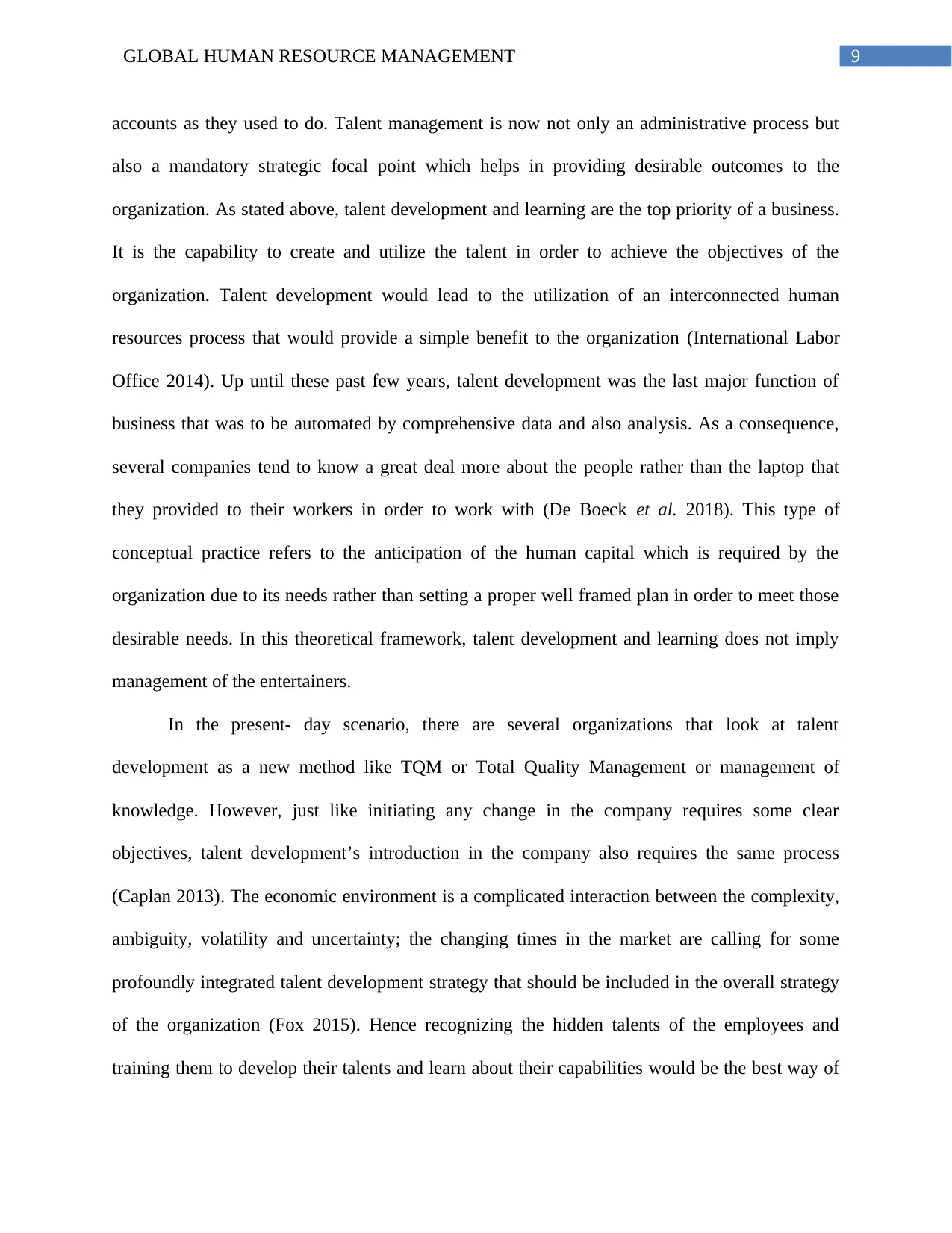
9GLOBAL HUMAN RESOURCE MANAGEMENT
accounts as they used to do. Talent management is now not only an administrative process but
also a mandatory strategic focal point which helps in providing desirable outcomes to the
organization. As stated above, talent development and learning are the top priority of a business.
It is the capability to create and utilize the talent in order to achieve the objectives of the
organization. Talent development would lead to the utilization of an interconnected human
resources process that would provide a simple benefit to the organization (International Labor
Office 2014). Up until these past few years, talent development was the last major function of
business that was to be automated by comprehensive data and also analysis. As a consequence,
several companies tend to know a great deal more about the people rather than the laptop that
they provided to their workers in order to work with (De Boeck et al. 2018). This type of
conceptual practice refers to the anticipation of the human capital which is required by the
organization due to its needs rather than setting a proper well framed plan in order to meet those
desirable needs. In this theoretical framework, talent development and learning does not imply
management of the entertainers.
In the present- day scenario, there are several organizations that look at talent
development as a new method like TQM or Total Quality Management or management of
knowledge. However, just like initiating any change in the company requires some clear
objectives, talent development’s introduction in the company also requires the same process
(Caplan 2013). The economic environment is a complicated interaction between the complexity,
ambiguity, volatility and uncertainty; the changing times in the market are calling for some
profoundly integrated talent development strategy that should be included in the overall strategy
of the organization (Fox 2015). Hence recognizing the hidden talents of the employees and
training them to develop their talents and learn about their capabilities would be the best way of
accounts as they used to do. Talent management is now not only an administrative process but
also a mandatory strategic focal point which helps in providing desirable outcomes to the
organization. As stated above, talent development and learning are the top priority of a business.
It is the capability to create and utilize the talent in order to achieve the objectives of the
organization. Talent development would lead to the utilization of an interconnected human
resources process that would provide a simple benefit to the organization (International Labor
Office 2014). Up until these past few years, talent development was the last major function of
business that was to be automated by comprehensive data and also analysis. As a consequence,
several companies tend to know a great deal more about the people rather than the laptop that
they provided to their workers in order to work with (De Boeck et al. 2018). This type of
conceptual practice refers to the anticipation of the human capital which is required by the
organization due to its needs rather than setting a proper well framed plan in order to meet those
desirable needs. In this theoretical framework, talent development and learning does not imply
management of the entertainers.
In the present- day scenario, there are several organizations that look at talent
development as a new method like TQM or Total Quality Management or management of
knowledge. However, just like initiating any change in the company requires some clear
objectives, talent development’s introduction in the company also requires the same process
(Caplan 2013). The economic environment is a complicated interaction between the complexity,
ambiguity, volatility and uncertainty; the changing times in the market are calling for some
profoundly integrated talent development strategy that should be included in the overall strategy
of the organization (Fox 2015). Hence recognizing the hidden talents of the employees and
training them to develop their talents and learn about their capabilities would be the best way of
Paraphrase This Document
Need a fresh take? Get an instant paraphrase of this document with our AI Paraphraser
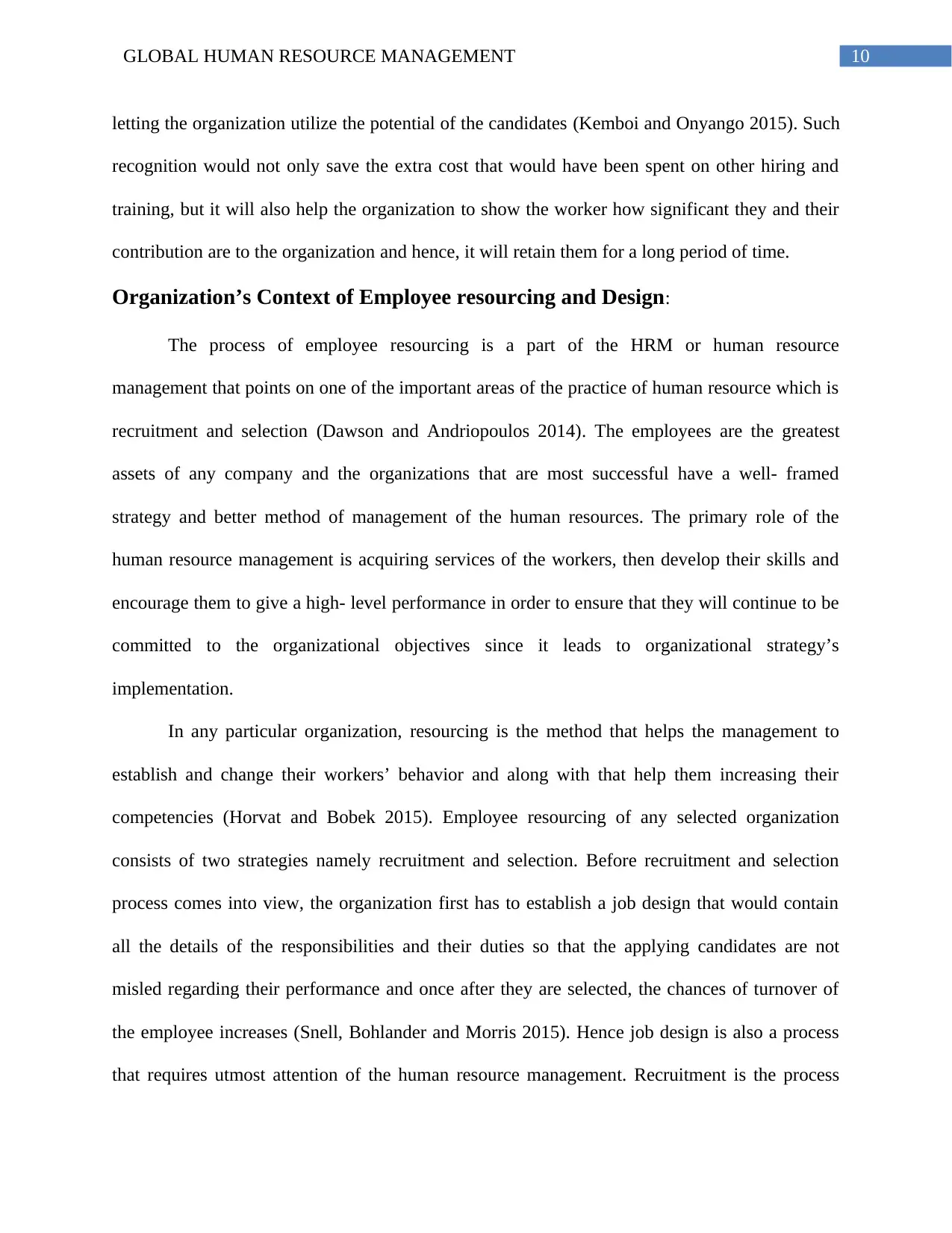
10GLOBAL HUMAN RESOURCE MANAGEMENT
letting the organization utilize the potential of the candidates (Kemboi and Onyango 2015). Such
recognition would not only save the extra cost that would have been spent on other hiring and
training, but it will also help the organization to show the worker how significant they and their
contribution are to the organization and hence, it will retain them for a long period of time.
Organization’s Context of Employee resourcing and Design:
The process of employee resourcing is a part of the HRM or human resource
management that points on one of the important areas of the practice of human resource which is
recruitment and selection (Dawson and Andriopoulos 2014). The employees are the greatest
assets of any company and the organizations that are most successful have a well- framed
strategy and better method of management of the human resources. The primary role of the
human resource management is acquiring services of the workers, then develop their skills and
encourage them to give a high- level performance in order to ensure that they will continue to be
committed to the organizational objectives since it leads to organizational strategy’s
implementation.
In any particular organization, resourcing is the method that helps the management to
establish and change their workers’ behavior and along with that help them increasing their
competencies (Horvat and Bobek 2015). Employee resourcing of any selected organization
consists of two strategies namely recruitment and selection. Before recruitment and selection
process comes into view, the organization first has to establish a job design that would contain
all the details of the responsibilities and their duties so that the applying candidates are not
misled regarding their performance and once after they are selected, the chances of turnover of
the employee increases (Snell, Bohlander and Morris 2015). Hence job design is also a process
that requires utmost attention of the human resource management. Recruitment is the process
letting the organization utilize the potential of the candidates (Kemboi and Onyango 2015). Such
recognition would not only save the extra cost that would have been spent on other hiring and
training, but it will also help the organization to show the worker how significant they and their
contribution are to the organization and hence, it will retain them for a long period of time.
Organization’s Context of Employee resourcing and Design:
The process of employee resourcing is a part of the HRM or human resource
management that points on one of the important areas of the practice of human resource which is
recruitment and selection (Dawson and Andriopoulos 2014). The employees are the greatest
assets of any company and the organizations that are most successful have a well- framed
strategy and better method of management of the human resources. The primary role of the
human resource management is acquiring services of the workers, then develop their skills and
encourage them to give a high- level performance in order to ensure that they will continue to be
committed to the organizational objectives since it leads to organizational strategy’s
implementation.
In any particular organization, resourcing is the method that helps the management to
establish and change their workers’ behavior and along with that help them increasing their
competencies (Horvat and Bobek 2015). Employee resourcing of any selected organization
consists of two strategies namely recruitment and selection. Before recruitment and selection
process comes into view, the organization first has to establish a job design that would contain
all the details of the responsibilities and their duties so that the applying candidates are not
misled regarding their performance and once after they are selected, the chances of turnover of
the employee increases (Snell, Bohlander and Morris 2015). Hence job design is also a process
that requires utmost attention of the human resource management. Recruitment is the process
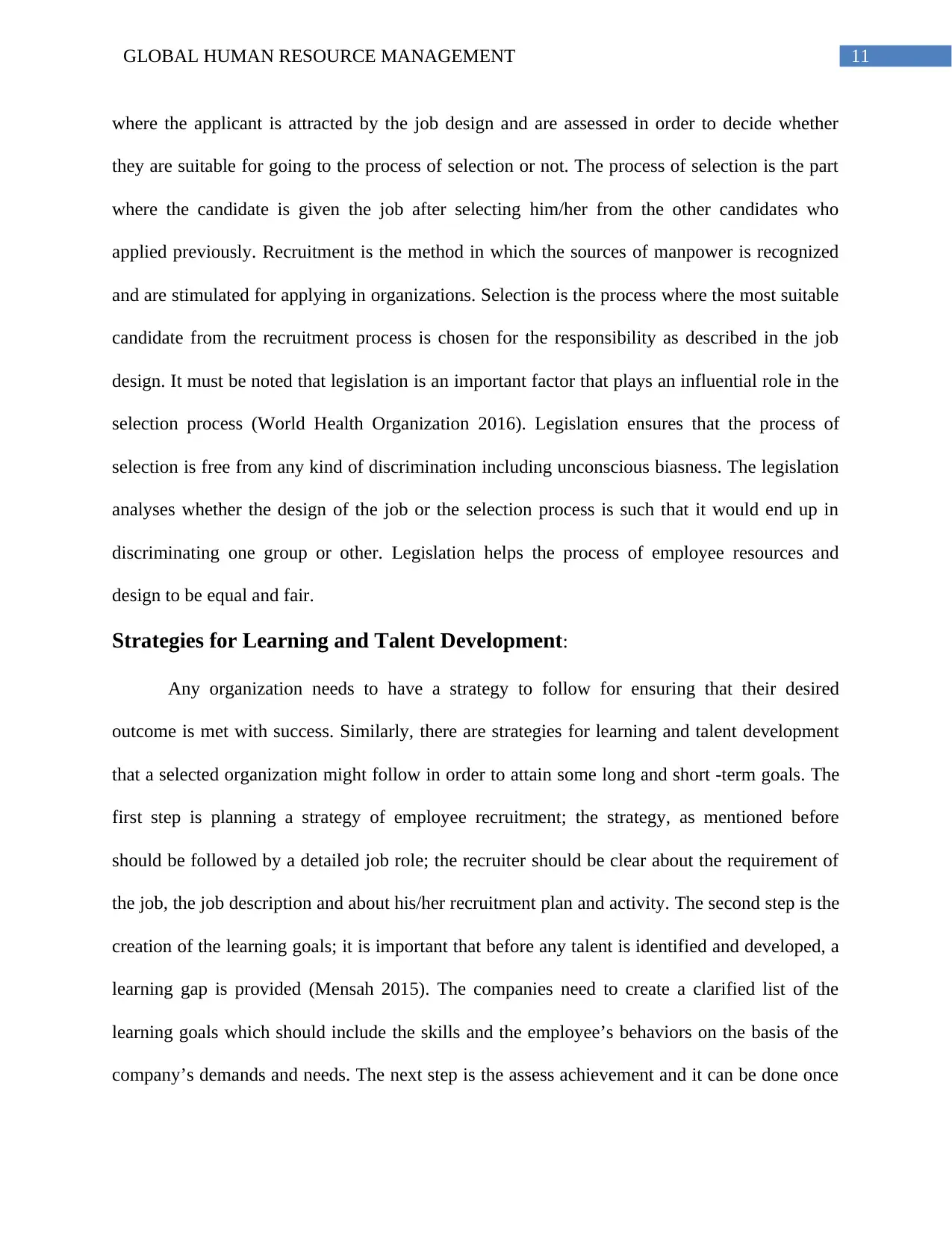
11GLOBAL HUMAN RESOURCE MANAGEMENT
where the applicant is attracted by the job design and are assessed in order to decide whether
they are suitable for going to the process of selection or not. The process of selection is the part
where the candidate is given the job after selecting him/her from the other candidates who
applied previously. Recruitment is the method in which the sources of manpower is recognized
and are stimulated for applying in organizations. Selection is the process where the most suitable
candidate from the recruitment process is chosen for the responsibility as described in the job
design. It must be noted that legislation is an important factor that plays an influential role in the
selection process (World Health Organization 2016). Legislation ensures that the process of
selection is free from any kind of discrimination including unconscious biasness. The legislation
analyses whether the design of the job or the selection process is such that it would end up in
discriminating one group or other. Legislation helps the process of employee resources and
design to be equal and fair.
Strategies for Learning and Talent Development:
Any organization needs to have a strategy to follow for ensuring that their desired
outcome is met with success. Similarly, there are strategies for learning and talent development
that a selected organization might follow in order to attain some long and short -term goals. The
first step is planning a strategy of employee recruitment; the strategy, as mentioned before
should be followed by a detailed job role; the recruiter should be clear about the requirement of
the job, the job description and about his/her recruitment plan and activity. The second step is the
creation of the learning goals; it is important that before any talent is identified and developed, a
learning gap is provided (Mensah 2015). The companies need to create a clarified list of the
learning goals which should include the skills and the employee’s behaviors on the basis of the
company’s demands and needs. The next step is the assess achievement and it can be done once
where the applicant is attracted by the job design and are assessed in order to decide whether
they are suitable for going to the process of selection or not. The process of selection is the part
where the candidate is given the job after selecting him/her from the other candidates who
applied previously. Recruitment is the method in which the sources of manpower is recognized
and are stimulated for applying in organizations. Selection is the process where the most suitable
candidate from the recruitment process is chosen for the responsibility as described in the job
design. It must be noted that legislation is an important factor that plays an influential role in the
selection process (World Health Organization 2016). Legislation ensures that the process of
selection is free from any kind of discrimination including unconscious biasness. The legislation
analyses whether the design of the job or the selection process is such that it would end up in
discriminating one group or other. Legislation helps the process of employee resources and
design to be equal and fair.
Strategies for Learning and Talent Development:
Any organization needs to have a strategy to follow for ensuring that their desired
outcome is met with success. Similarly, there are strategies for learning and talent development
that a selected organization might follow in order to attain some long and short -term goals. The
first step is planning a strategy of employee recruitment; the strategy, as mentioned before
should be followed by a detailed job role; the recruiter should be clear about the requirement of
the job, the job description and about his/her recruitment plan and activity. The second step is the
creation of the learning goals; it is important that before any talent is identified and developed, a
learning gap is provided (Mensah 2015). The companies need to create a clarified list of the
learning goals which should include the skills and the employee’s behaviors on the basis of the
company’s demands and needs. The next step is the assess achievement and it can be done once
⊘ This is a preview!⊘
Do you want full access?
Subscribe today to unlock all pages.

Trusted by 1+ million students worldwide
1 out of 18
Related Documents
Your All-in-One AI-Powered Toolkit for Academic Success.
+13062052269
info@desklib.com
Available 24*7 on WhatsApp / Email
![[object Object]](/_next/static/media/star-bottom.7253800d.svg)
Unlock your academic potential
Copyright © 2020–2025 A2Z Services. All Rights Reserved. Developed and managed by ZUCOL.


